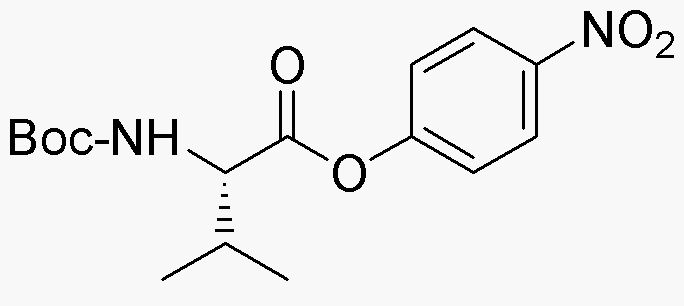Boc-L-valine 4-nitrophenyl ester is widely utilized in research focused on:
- Peptide Synthesis: This compound serves as a valuable building block in the synthesis of peptides, allowing researchers to create specific sequences for various biological studies.
- Drug Development: Its application in the pharmaceutical industry aids in the design of prodrugs, which can enhance the bioavailability of active pharmaceutical ingredients.
- Bioconjugation: The compound is used in bioconjugation processes, facilitating the attachment of biomolecules to surfaces or other molecules, which is crucial in diagnostics and therapeutic applications.
- Research on Enzyme Activity: Boc-L-valine 4-nitrophenyl ester is employed in assays to study enzyme kinetics, helping researchers understand enzyme mechanisms and develop inhibitors.
- Protein Labeling: This chemical can be used for labeling proteins, enabling visualization and tracking in cellular studies, which is essential for understanding protein function and interactions.
General Information
Properties
Safety and Regulations
Applications
Boc-L-valine 4-nitrophenyl ester is widely utilized in research focused on:
- Peptide Synthesis: This compound serves as a valuable building block in the synthesis of peptides, allowing researchers to create specific sequences for various biological studies.
- Drug Development: Its application in the pharmaceutical industry aids in the design of prodrugs, which can enhance the bioavailability of active pharmaceutical ingredients.
- Bioconjugation: The compound is used in bioconjugation processes, facilitating the attachment of biomolecules to surfaces or other molecules, which is crucial in diagnostics and therapeutic applications.
- Research on Enzyme Activity: Boc-L-valine 4-nitrophenyl ester is employed in assays to study enzyme kinetics, helping researchers understand enzyme mechanisms and develop inhibitors.
- Protein Labeling: This chemical can be used for labeling proteins, enabling visualization and tracking in cellular studies, which is essential for understanding protein function and interactions.
Documents
Safety Data Sheets (SDS)
The SDS provides comprehensive safety information on handling, storage, and disposal of the product.
Product Specification (PS)
The PS provides a comprehensive breakdown of the product’s properties, including chemical composition, physical state, purity, and storage requirements. It also details acceptable quality ranges and the product's intended applications.
Certificates of Analysis (COA)
Search for Certificates of Analysis (COA) by entering the products Lot Number. Lot and Batch Numbers can be found on a product’s label following the words ‘Lot’ or ‘Batch’.
*Catalog Number
*Lot Number
Certificates Of Origin (COO)
This COO confirms the country where the product was manufactured, and also details the materials and components used in it and whether it is derived from natural, synthetic, or other specific sources. This certificate may be required for customs, trade, and regulatory compliance.
*Catalog Number
*Lot Number
Safety Data Sheets (SDS)
The SDS provides comprehensive safety information on handling, storage, and disposal of the product.
DownloadProduct Specification (PS)
The PS provides a comprehensive breakdown of the product’s properties, including chemical composition, physical state, purity, and storage requirements. It also details acceptable quality ranges and the product's intended applications.
DownloadCertificates of Analysis (COA)
Search for Certificates of Analysis (COA) by entering the products Lot Number. Lot and Batch Numbers can be found on a product’s label following the words ‘Lot’ or ‘Batch’.
*Catalog Number
*Lot Number
Certificates Of Origin (COO)
This COO confirms the country where the product was manufactured, and also details the materials and components used in it and whether it is derived from natural, synthetic, or other specific sources. This certificate may be required for customs, trade, and regulatory compliance.


